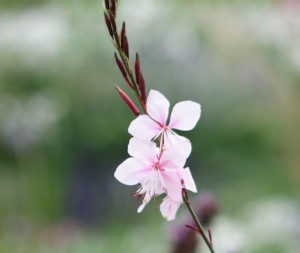 You may not have noticed, but gauras have exploded in a big way. This mass detonation has taken place over the last two decades, and while the world at large may have perceived it as white noise, it resounded in horticultural circles.
You may not have noticed, but gauras have exploded in a big way. This mass detonation has taken place over the last two decades, and while the world at large may have perceived it as white noise, it resounded in horticultural circles.
Gaura lindheimeri, a perennial also known as Lindheimer’s beeblossom, wandflower, or just plain gaura, is not particularly volatile-looking. In fact, the plants appear deceptively fragile, rising from three to five feet on slender, wand-like stems. The combined effect of the slender stalks and small, narrow, alternate leaves reminds me of young willow stems.
The flowers are similarly dainty, resembling butterflies or small orchids, with petals that may be white, pink, rose, or near-red. Like snapdragons, individual gaura blooms appear together in panicles at the tops of the stalks. Each lasts only one day. Gaura flowers open sequentially, so every panicle features a combination of open blooms and unopened buds.
So why have these slender North American native plants exploded? Because breeders found that they are exceptionally tough, surviving on dry, rocky soil or lean prairie ground anchored by sturdy taproots that reach down deep, the better to get through harsh conditions, including drought. Combine that toughness with the obvious beauty of the flowers and you get something that is primed to make a big noise among gardeners.
One of the most popular gaura varieties is ‘Siskiyou Pink’, discovered at a rare plant nursery in Oregon. ‘Siskiyou Pink’ begat a shorter—12 inches tall—variety christened ‘Crimson Butterflies’. Marketers came up with the “crimson” name for flower petals that are actually hot pink. Blame that on hyperbole.
Plant breeders tend to patent everything these days, and the patented Butterflies series, all bred in Australia from ‘Siskiyou Pink’, contains other gauras including ‘Whirling Butterflies’, ‘Blushing Butterflies’ and ‘Sunny Butterflies’. The latter is distinguished by white leaf edges, which make it “sunny”.
Another patented series uses the name “Ballerina”, and includes ‘Ballerina White’, ‘Ballerina Blush’ and ‘Ballerina Rose’. The charm of these ballerinas is that they are relatively compact, growing to only 24 inches tall.
Another hot pink variety goes by the name ‘Gaudi Red’. For those who are curious, the name comes not from the flowers, but from the dark reddish bronze stems and leaves, which top out at about 16 inches.
The gaura explosion resulted in a large number of named varieties, so if you are inclined to buy plants, select for color and size. Shorter varieties also do well in containers. All appreciate a sunny location with lean, well-drained soil amended with fine gravel or sand if necessary. Heavy, moisture-retentive clay will encourage root rot. Soil that is too rich fosters lots of leaf and stem growth, but fewer flowers.
Gauras are most beautiful grown in clumps, which form naturally when the plants are well situated. Clumping allows the slender stalks to support each other, which eliminates the need for staking of the taller varieties. They combine nicely with other prairie denizens like coneflowers and grasses. Best of all, they bloom over a long season.
So why is such a beautiful and useful plant stuck with an unwieldy species name like “lindheimeri”? As is often the case with plant names, it harkens back to a person, specifically nineteenth century German immigrant, Ferdinand Lindheimer, who is also sometimes known as “the father of Texas botany.”
The university-educated Lindheimer emigrated from Europe in the early nineteenth century and eventually ended up in the German settlement of New Braunfels near San Antonio, Texas. He spent a large chunk of his working life as founding editor of the New Braunfels newspaper, but his passion was botany. He roamed over swathes of the Texas hill country and beyond, sometimes helped by members of indigenous tribes, gathering and preserving botanical specimens, which he sent to a botanist friend for identification. The friend reciprocated by naming many of Lindheimer’s finds in his honor.
In the spring, you may be able to find gauras at local nurseries and garden centers. You can also try the selection at High Country Gardens; (800) 925-9387; www.highcountrygardens.com.
